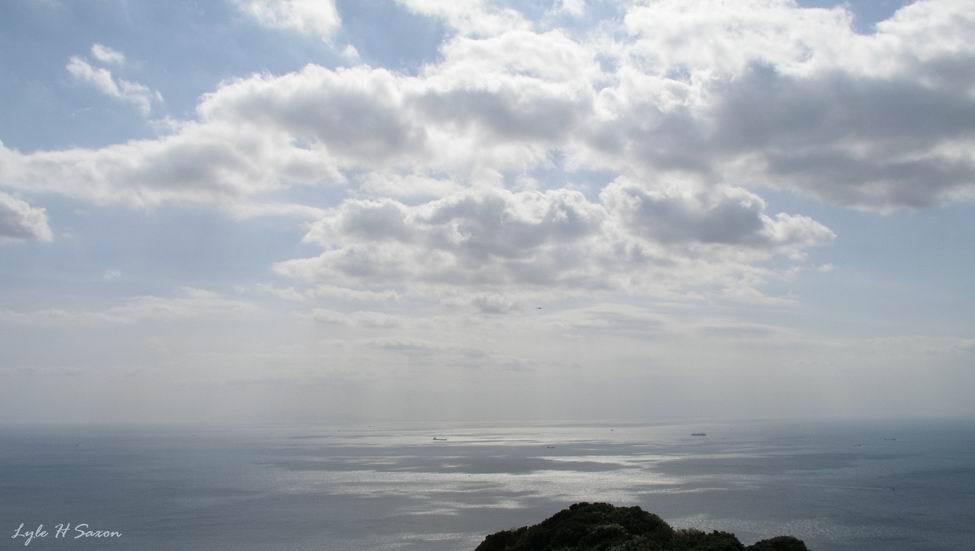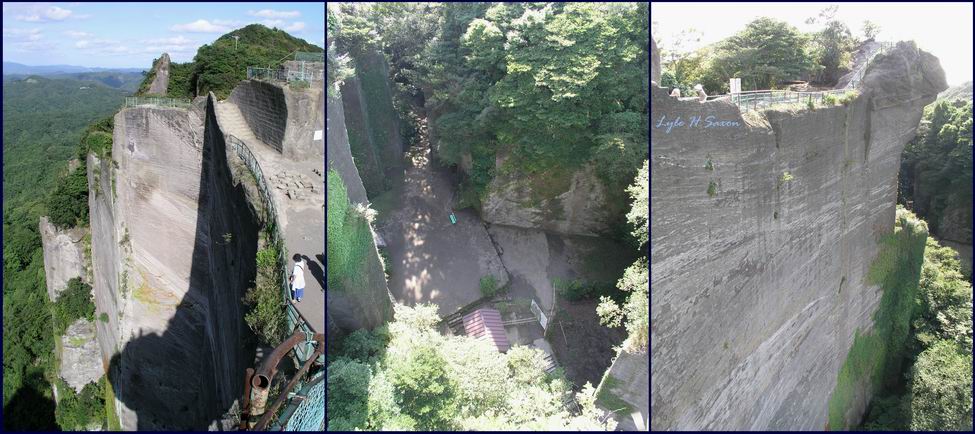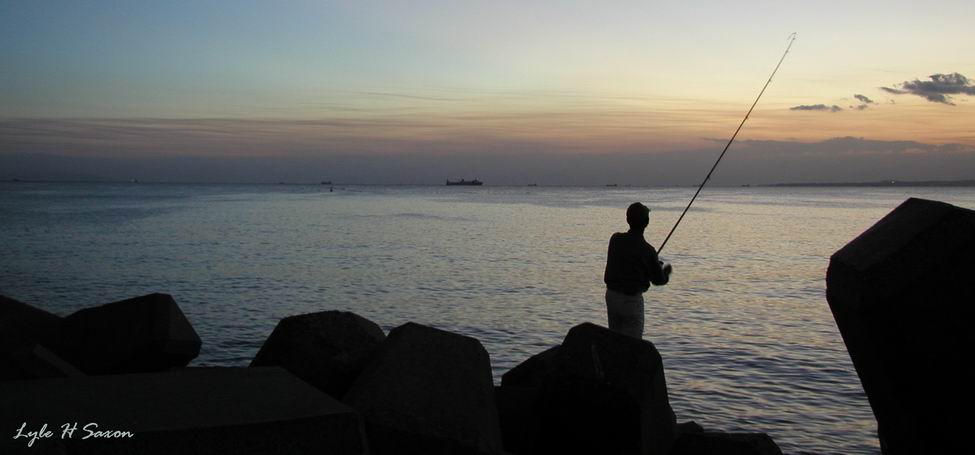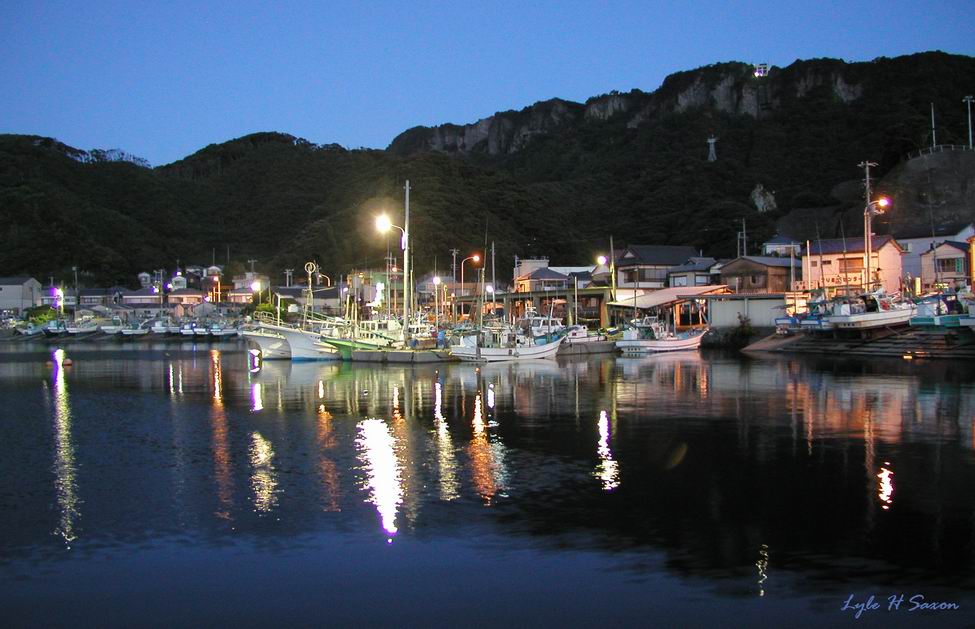| Boso Peninsula
- Nokogiriyama, Stone Buddha, & Evening Kanaya Bay (Page-8)
1, 2, 3, 4, 5, 6, 7, 8, 9 Back to Kanaya - this time specifically to go to the top of Mt. Nokogiri - first wandering around a bit within the small fishing village of Kanaya, and then riding the gondola up to the top. The upper station of the gondola (below right) retains a feel from a few decades ago, and so will likely be radically changed in the not-to-distant future. Really old things in Japan are carefully preserved, but anything newer than about 150 years old is considered too new to be worthy of preserving - thus there are whole periods of architectural styles that have come and gone, with very few surviving examples left. Up on top of Mt. Nokogiri. (Middle) - Looking down the peninsula at the next town. Further along in this same direction is Tateyama. The town that is partially visible in the left picture above is near the Kanaya ferry terminal. Up on top, the view out over Tokyo Bay is a good one on clear days. The night view must be nice, but the last cable car run is before sunset, so I've never stayed long enough to see it. I might try staying after that last easy ride down to see it sometime, and then just walk down the mountain on the access road for the nearby temple - it's not all that far I don't think (but I'm only guessing, so don't take my word for it!). The nice looking valley in the middle picture above was cut out of rock - this mountain was the source of stone used in the building of many of the Meiji Era western style buildings (in Yokohama and elsewhere) and was a quarry on into the 20th century. The most dramatic evidence of the quarry are the sheer cliffs resulting from the cutting away of the mountain's rock. Picture yourself standing where the person in the lower left picture is - leaning over the rail and looking straight down isn't something you'd like to do if you're afraid of heights! I'm not, but it was still a bit of a thrill. The middle picture below is hard to decipher, but it's the same valley as the middle picture above. One view from ground level and one from the top of the cliff. The stairs below indicate the relative softness of the rock - people's footsteps have practically worn the steps into a ramp. (Middle below) - Another view down the coast towards the tip of the Boso Peninsula. (Right below) - Stone statues at the Nihon-dera temple not far from the top of Mt. Nokogiri. If you want to properly explore this area - be prepared for a lot of walking up and down long staircases! Easier than hiking up and down rough trails, but quite a workout in the heat nonetheless! (These pictures were all taken in late summer.) This stone Buddha stature is apparently the largest statue of Buddha in Japan. The Nara Buddhist stature is much more famous, and is the largest bronze statue of Buddha, but this one is larger if you allow for different materials. Apparently this was carved from the solid rock of the mountain. As the evening approached and the shadows lengthened - I reluctantly headed for the last gondola ride back down the mountain. If only they had a later one that would allow a good look at the night view! Back down the mountain, I took a walk along the waterfront - photographing a sunset that looked remarkably similar to a painting my parents had in their living room as I was growing up - and then I explored the fishing boats and fishing bipeds. It was an enjoyable time I spent in the twilight - wandering around in a relaxed atmosphere at the end of the day and in the near end of summer. Tokyo is exciting, but it offers much too little in the simple pleasures of being under an open sky and in touch with the time of day, the time of season, the time of your life..... (Below) - Taken from the concrete and rock barrier that protects the small harbor and its fleet of fishing boats. The light at the top of the mountain is the gondola landing... do they leave lights on there all night, or was someone still working there - cleaning up in the restaurant and souvenir shops? (Below left) - Not long after watching a fishing boat come back to the harbor, I noted the time and hurried back to the ferry terminal for a ride on the last boat across. (Below middle) - The inside of the ferry - a nice boat that always makes me wish the ride across took two or three times longer than it does! (Below right) - Cars unloading on the Kanagawa (Tokyo) side of Tokyo Bay). After getting off the ferry, I looked back at the boat for a bit and then walked back to Kurihama Station. (Below middle) - The road illuminated by the headlights of a car behind me. (Below right) - The street that leads to (or away, depending on the direction of your journey) Kurihama Station. "Back to city life..." I thought with some reluctance as I approached the station for the first of many trains back to my apartment...... Copyright 2006 by Lyle (Hiroshi) Saxon, Images Through Glass, Tokyo |














